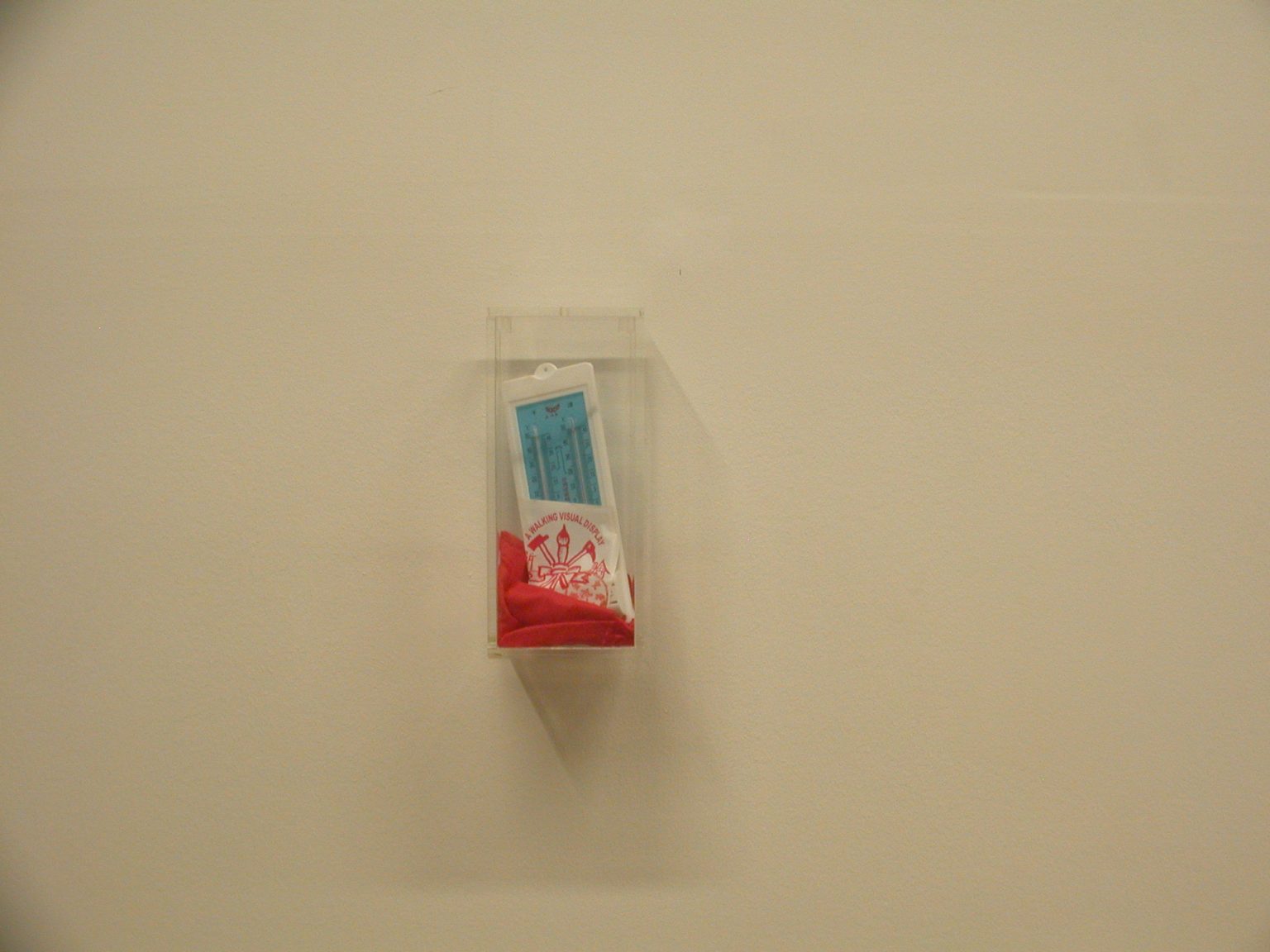Shanghai Assemblage 2000-2004: Light as Fuck!
Location: The National Museum of Contemporary Art, Oslo
Duration: Apr. 17 – Aug. 15, 2004
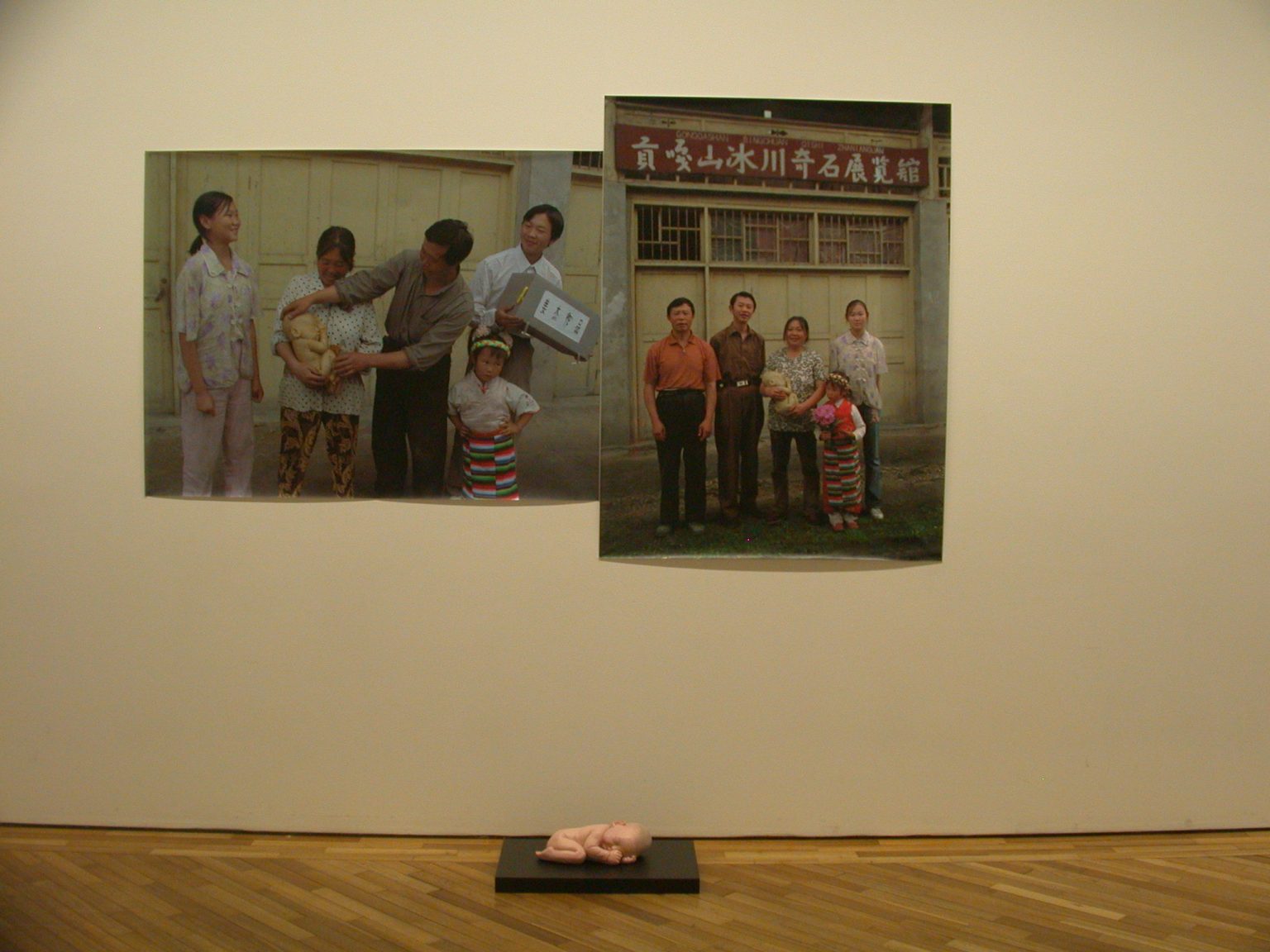
Shanghai Assemblage 2000-2004: Light as Fuck!
Shanghai is one of the places in the world where change takes place at high speed and in a big way. With this as a backdrop, the exhibition presents various reactions to and participation in this ever changing landscape of re-invention. Something which is simultaneously heavy and light. This is a fascintating, broad presentation of art from the last four years. The main focus is upon film and video art, but performance, photography, internet art, painting and installation are also represented. The themes and concepts are also broadly based: the idea of being in transit, the meeting with the unknown, falling in love, architectural change, terrorism, contemporary ideas contra tradition, the play upon words, the long march towards (and past) modernity etc. This is an exhibition with humour, warmth and images/ideas that have an impact. Chen Shaoxiong, Hue Jie Ming, Liang Yue, Song Tao, Xu Zhen, Yang Fu Dong, Yang Zhenzhong, Zhang Peili, Zhou Hongxiang, Laura Beloff and Jin Jiangbo, students from the Shanghai University Art College and The National Academy of Fine Art, Oslo, Lu Jie, Qui Zhijie and a selected group of artists who have participated on the Long March (2002-2003).
Wang Jinsong
Wang Jinsong, New Long March Slogan, Sound Installation, 2002
Wang Jinsong’s New Long March Slogan was first realized along the course of the Long March from June to August 2002 at the sites of Ruijin, Jiangxi Province; Jingangshan Mountain, Jiangxi Province; Quanzhou, Guangxi; Guilin, Guangxi Province; Kunming, Yunan Province; Lijiang, Yunan Province; Lugu Lake, Yunan-Sichuan Province; Zunyi, Guizhou Province; Maotai, Guizhou Province; Xichang, Sichuan; Moxi, Sichuan Province; and Luding Bridge, Sichuan.
New Long March Slogan is one of the works of The Long March: A Walking Visual Display that was realized over the entire course of the march. The recording was created in twelve different languages, including Mandarin Chinese, English, and ten different Chinese dialects, all spoken in the form of a formal news report. The work is made up of readings of Long March curators’ words and plans mixed together with excerpts from famous contemporary art texts published in China. Wang Jinsong first exhibited his work using Jiangxi dialect at Ruijin, Jiangxi Province, the first site of the Long March. At each of the following sites, he continued to record and exhibit the work in the dialect of that respective site, including Guangxi, Yunan, Guizhou, and Sichuanese dialects, continuing through the twelve completed sites of the march.
Now, at the thirteenth site of the Long March, the 25000 Cultural Transmission Center in Beijing, Wang Jinsong is the first “professional” contemporary artist invited to join this exhibition and create a dialogue with the other works created by the “amateur” artists in “The Power of the Public Realm.”
The current exhibition design of New Long March Slogan is as follows: Several cassette players have been placed throughout the Long March Space together with the works from phases one through three of the “The Power of the Public Realm” exhibition. The ten cassette players broadcast Wang Jinsong’s work in ten different dialects all at once, creating a mixture of sound and language. If, as a visitor to the gallery, you would like to listen to one particular recording, please refer to the diagram below to determine the placement of that recording so that you may get close enough to single it out.

Qiu Zhijie
Qiu Zhijie, Left/Right, 10m x 70cm photo carpet, object installation, proposal
Qiu Zhijie, the artist and co-curator of the Long March, created a special pair of shoes by carving the ancient Chinese character for “left” onto the bottom of the right shoe and “right” onto the bottom of the left shoe. He then wore these shoes to walk through the twelve completed sites of the Long March, thus mapping and documenting the ideological and political negotiations involved in China society. In the Shanghai Assemblage show, the photographic records of the footprints themselves and of the sites where the footprints were made will be used to create a montage that will be in the form of a photo carpet. The carpet itself will extend from one end of the room to the other, beginning at the entrance. The carpet will be printed using economical digital printing in China. In the center of the right wall, the pair of shoes will be displayed alongside Qiu Zhijie’s original proposal for the project.
Qiu Zhijie, “Left/Right,” performance
This work is carried out throughout the whole journey of the Long March. He wears a special pair of shoes of which the character for “Right” is carved on the left sole while that for “Left” is carved on the right. He has left footprints of “left” and “right” all along the route, however, they remain invisible at most times. For this specific site of Luding Bridge, he crossed the bridge blind-folded. He precariously moves across the bridge with his body swaying from left to right.
Everyday during the Long March, Qiu Zhijie wore a pair of shoes with soles engraved with the characters for “left” and “right.” The catch is that “left” was engraved on the right sole, and vice versa. So technically, this work was realized at every point along the Long March where he left footprints, though the prints were often invisible. The difference between everyday behavior and theatricality, between artwork and non-artwork, the vagueness of the border between intention and non-intention made this work become randomly apparent and invisible, appearing and disappearing with no regularity. His walking became a dialectic of forgetting and remembering: walking is inherently continuous, only consciousness is fragmented. Today, amidst the theatricality of Luding Bridge, Qiu Zhijie decided to leave some intentional traces.
He placed segments of wet cloth at five intervals across the bridge, and covered his eyes with a black blindfold. He walked wobblingly across the bridge from the west to the east tower, leaving clear footprints in water on the wooden planks.
The danger of walking Luding Bridge turned this work into a commentary on the fate of the avant-garde
As an artist and at the same time a curator of the Long March, every step Qiu takes in thought is as adventurous as a physical step across the bridge, and as the work suggests, involves a constant negotiation between left and right. Every step involves a clear choice between left and right, radical and conservative, right and wrong. If judgments can be so clear, is there any need for a Long March?
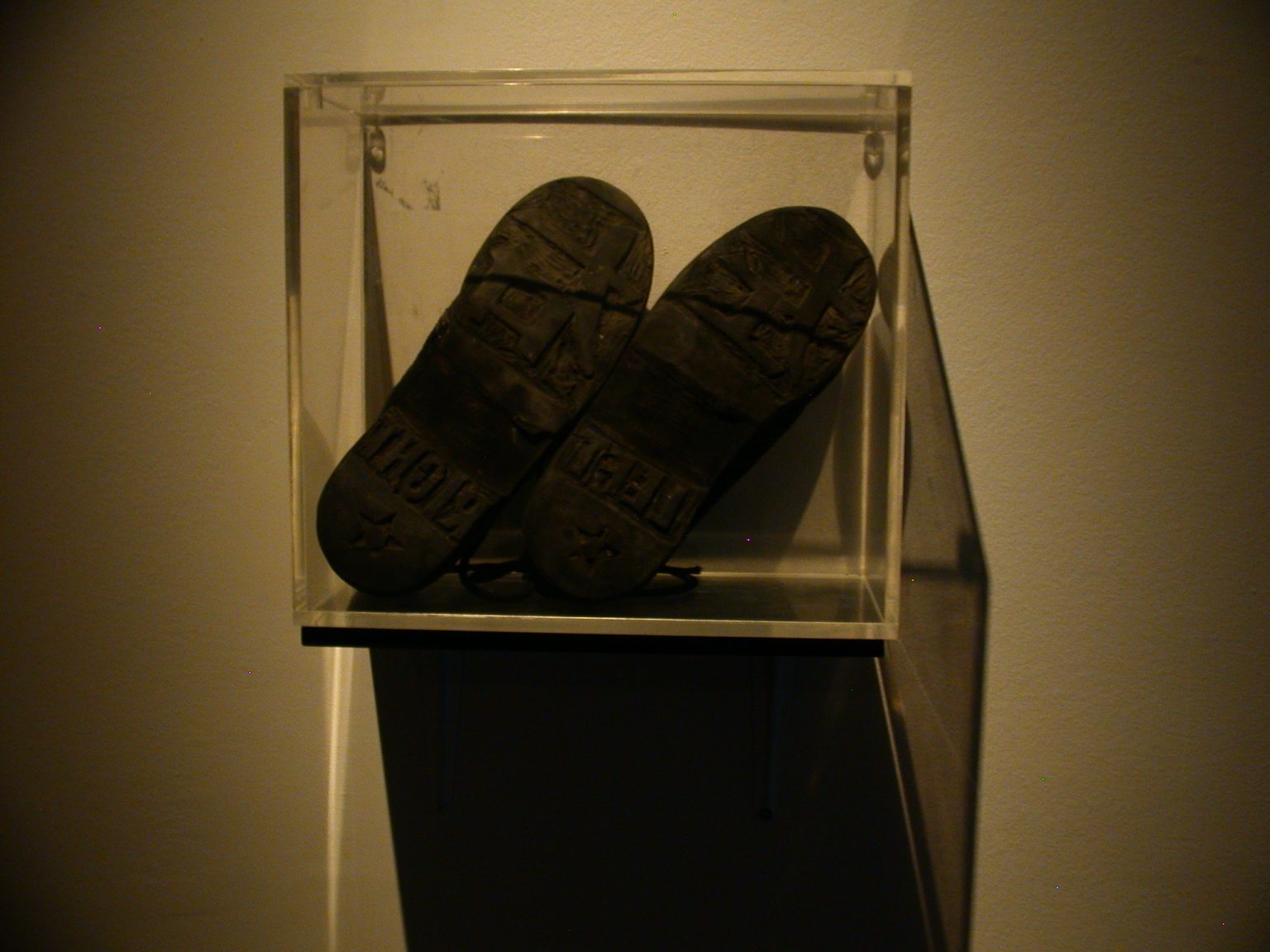
Qin Ga
Qin Ga, The Miniature Long March
The Long March Tatoo, work in progress, date of documentation July 1st through Sep. 1st, 2002. Part of Long March Project.
- During the three months between July 1 and October 1, 2002, tattoo a map showing the route of the art project, “Long March – A Walking Visual Display” on my chest (or back, depending upon technical issues).
- Keep constant contact with the Long March main contingents. For instance, if they arrive to Ruijin on July 1 and reach Jingganshan on July 8, I will tattoo the route from Ruijin to Jingganshan from the 1st to the 8th in Beijing. A “Small Red Flag” will be tattooed on every site. With this analogy, I will complete the Long March with a “steel needle” on my body on October 1st, also noting the completion of the tattooing process. Document the process.
- About twenty photographs and video documentations will comprise the exhibition.
- Keep in contact with the Long March detachment to adjust the actual time of progress and the route to be tattooed.
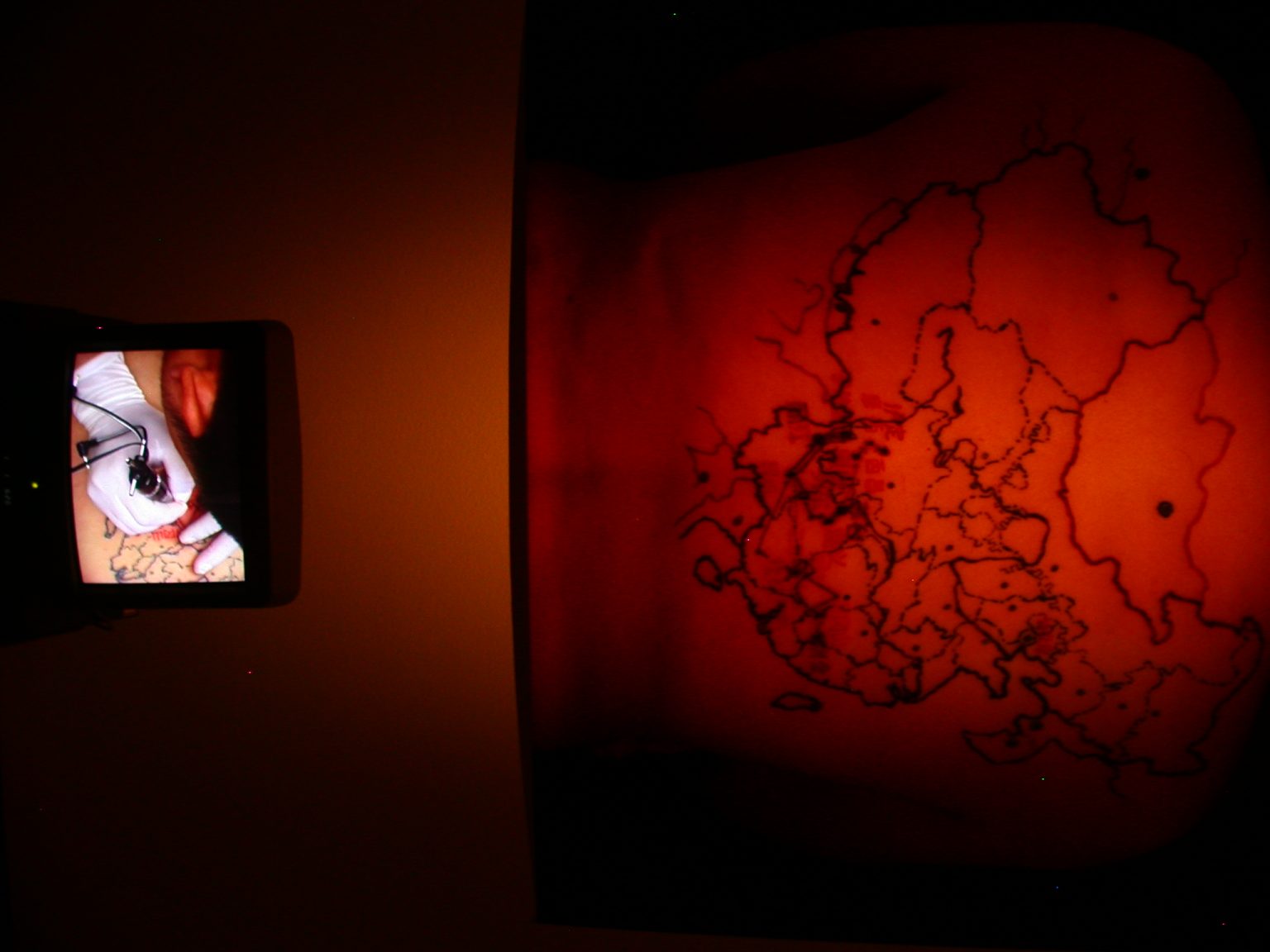
Zhou Xiaohu, Shi Yong
Zhou Xiaohu, Utopia, video projection (projector needed)
On the right hand wall of the room, on the side of Qiu Zhijie’s installation nearest to the entrance, I would like to project Zhou Xiaohu’s video Utopia, which you have seen when you were in Suzhou during the Shanghai Biennale.
Shi Yong, Long March in Shanghai, video projection (projector needed)
Opposite from Zhou Xiaohu’s video projection will be the projection of Shi Yong’s Long March in Shanghai. In this work, Shi Yong visits different places in Shanghai that are named after Long March locations. This work is currently in the final production period, so I have not yet provided you with an image.

Jiang Jie
Jiang Jie, Sending Off the Red Army: To Commemorate the Mothers on the Road of the Long March, print, sculpture
During the Long March traveling exhibition, artist Jiang Jie created twenty statues of asexual babies which she then gave to families at different locations along the march as an “adoption“ process. The concept derives from the historical Long March when many wives of leaders were forced to give up their children as soon as they were born because of the harsh conditions of the march. After the Long March, these babies could never be found again by their mothers. In the new Long March, Jiang Jie sought out people to adopt contemporary art. The families that adopted the statues were asked to take one photograph each year on the anniversary of the adoption. While the families in the photographs will change, the babies themselves will remain constant. After twenty years, these four hundred photographs will be collected and put together for an exhibition which will explore the development of personal histories. In the Shanghai Assemblage, a print of one of the photographs illustrating the adoption process will be hung on the far end of the right wall. One of the baby sculptures will be displayed in front of the print.

Sui Jianguo
Sui Jianguo, Karl Marx and Jesus Christ in China, print, sculpture
Opposite from Jiang Jie’s work will be a similar presentation of Sui Jianguo’s piece. Sui Jianguo’s Karl Marx and Jesus Christ in China involved carrying sculptures of the two figures wearing Mao uniforms through different locations of the Long March. In Shanghai Assemblage, we will hang a print of one of the photographic records of the work in order to illustrate the story of how it was realized on the far end of the left wall, and in front we will place the original two sculptures as artifacts from the performance.
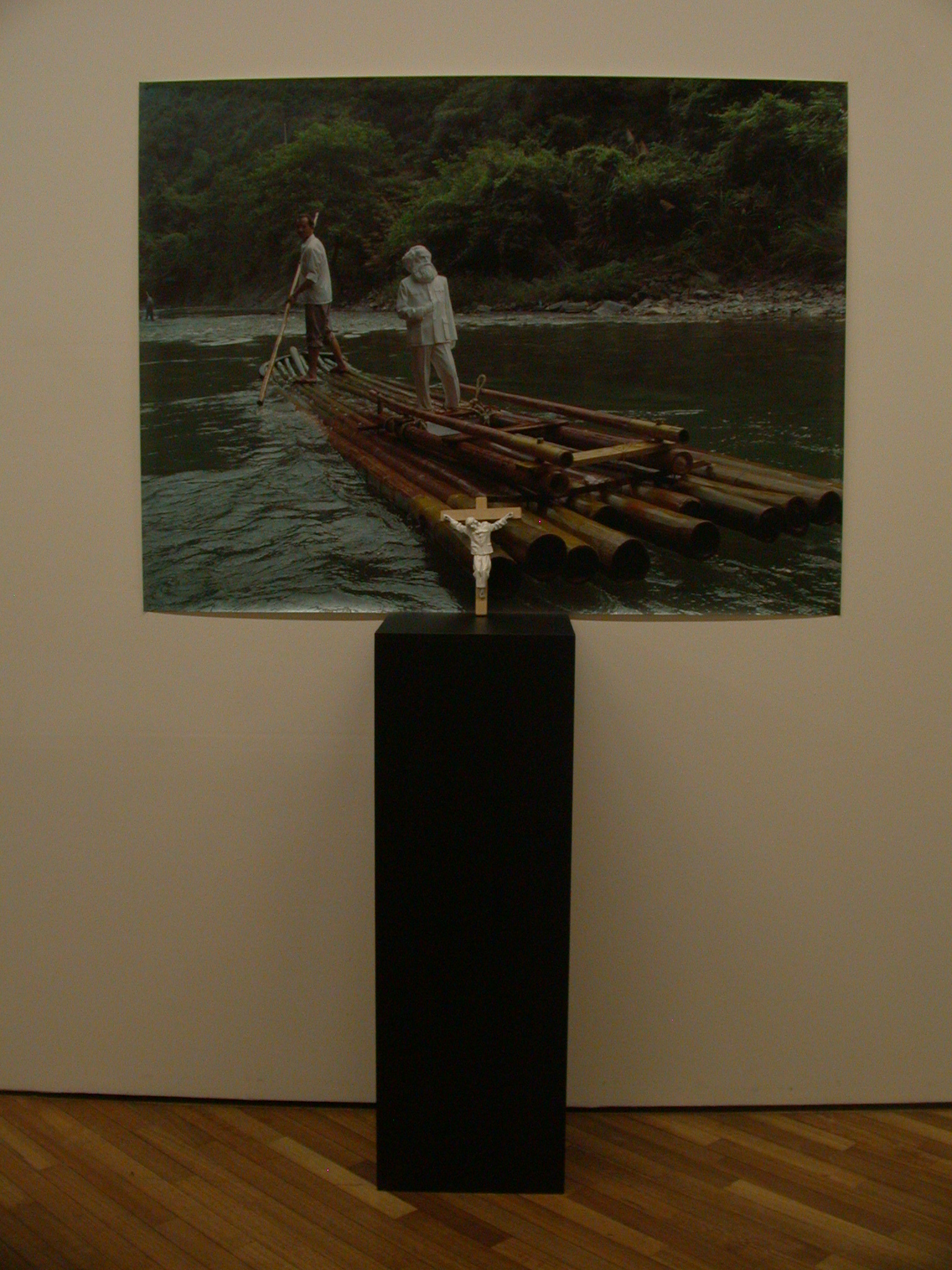
Xiao Xiong
Xiao Xiong’s In and Out piece was first realized throughout the course of The Long March: A Walking Visual Display. While the exhibition itself was following the path of Mao Zedong’s historical Long March, artist Xiao Xiong was traveling the same path, but in reverse direction. As he traveled, he wheeled a medium-sized, red chest along with him. His journey began with a sculpture of Mao tucked inside the chest, but as he traveled, he was constantly exchanging the object in his chest for another object — the sculpture of Mao in exchange for a pen, a pen in exchange for an admission ticket to a local museum, etc. Each time he gave his object, he noted that it was from Mao Zedong. Part of the process involved in his project was that he was always working to renegotiate the value of his object — such as giving an admission ticket which was of little use to a resident in a different city to a local artist in exchange for a painting. As he traveled, he documented his work with photographs of the objects and the participants at the sites of the exchanges. The final objects resulting from his series of exchanges were two thermometers.
In Shanghai Assemblage, Xiao Xiong will both display the objects of his project and will also recreate the exchange process. In the room itself, prints of his photo records will be joined together to form a long carpet that will be laid vertically along the floor of the space. The red chest that Xiao Xiong carried with him will be placed on the carpet, and on the end wall he will present his proposal for the project. On the side wall, he will display one of the thermometers in a frame as a work of art.
The other aspect of the exhibition of Xiao Xiong’s work will be the recommencement of the chain of exchanges, which will begin by using one of the thermometers that had been the final object of exchange in the past set. The artist has put forth two proposals to carry this out. We strongly recommend his first proposal in which he himself is present at the exhibition to make exchanges with audience members. However, if the museum is unable to accommodate bringing the artist to Oslo into their budget, we would like to suggest that a volunteer carry out the exchanges. Xiao Xiong has also proposed a second arrangement in which a Norwegian artist would be selected to perform the exchanges outside of the exhibition space by traveling to different places in Norway.
Xiao Xiong has stated the concept of his work as follows:
-The Long March is not only an event in the history of China but also in humanity’s history.
-There is a “Long March” in every place’s history; they only differ from one another in the way that they unfold.
The purpose of this exchange is to uncover and, at the same time, to re-cover a part of our history:
-The Long March is universal, but the exchanges themselves are individual. In the same way, history is written collectively, but events are experienced personally.
Exchange–Equality–Going beyond all boundaries, using the name of art.
A photo carpet of Xiao Xiong’s In/Out will run parallel to that of Qiu Zhijie’s Left/Right. The carpet will be the same in size and will similarly be made up of a montage of photographic records. I have attached a document giving a detailed explanation of Xiao Xiong’s work. Xiao Xiong’s traveling chest, proposal, and framed thermometer will be displayed on the left wall, directly across from Qiu Zhijie’s shoes.
